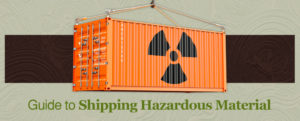
Shipping hazardous material isn’t like shipping ordinary material. While many of the aspects remain the same, the fact that the materials in transit are hazardous means there must be additional checks, labels and precautions put in place before the item can head out into shipping.
The reasons for this are simple. If something were to happen to this package in transit, with the contents becoming damaged, leaking or spilling, the consequences could be dramatic. People could be hurt, property could be damaged and hundreds or even thousands of dollars would likely need to be spent in the cleanup effort.
The best solution is to exercise additional levels of precaution whenever and wherever hazardous materials are involved. Today, we want to walk you through the basics of shipping hazardous materials, including learning what regulations apply, what type of products these regulations apply to and how to comply with them.
What Are the Different Types of Hazardous Material to Be Concerned With?
Hazardous materials are not a single, homogeneous group of substances that all fall under the same classification and can thus be treated all the same way. Instead, “hazardous material” is an umbrella term that describes a wide range of different substances with a variety of different properties, all of which require slightly different handling.
The broad categories that fall under the term hazardous material and that you may find yourself dealing with include:
- Explosives: Including mass explosive hazards, mass fire hazards and projection hazards.
- Gases: Including flammable gases, non-flammable gases and poisonous or toxic gases.
- Flammable liquids: Including liquids that have a flash point of no more than 141 degrees Fahrenheit.
- Flammable solids: Including spontaneously combustible materials and dangerous-when-wet materials.
- Oxidizing substances: Including oxidizers and organic peroxides.
- Toxic substances: Including toxic materials and infectious substances.
- Radioactive material: Including any materials, liquid or solid, which contain radiation.
- Corrosive material: Including any material with damagingly corrosive properties.
- Miscellaneous damaged goods: Including any substances that may be damaged in a way that makes them hazardous.
Of course, these categories are all well and good if you’re looking at the material itself and can see what it is. If all you’re looking at is a package, however, and you aren’t sure what’s in it or whether it might be hazardous, it can be more difficult to tell if the product inside falls into one of these categories or not.
If this is the case, examine the packaging for any of these keywords which might suggest the items contained within are hazardous:
- Acidic
- Volatile
- Caustic
- Toxic
- Combustible
- Refrigerated
- Compressed gas
- Radioactive
- Corrosive
- Explosive
- Poison
- Inflammable
- Flammable
- Infectious
If any of these words appear anywhere on a package, it’s safe to assume that the item contained within likely falls somewhere under the umbrella category of hazardous materials, and should be treated with an appropriate amount of caution and diligence.
Types of Regulations for Shipping
It should come as no surprise that the postal service does not allow you to simply place an explosive into an ordinary box, carry it to the post office and mail it off. This would be extremely unsafe and irresponsible, which is why there are many regulations in place preventing this. Most of us instinctively realize this, even if we might not know the exact letter of the rules preventing this means of transporting hazardous material.
But what exactly are the rules that regulate how to ship hazardous material? Let’s break them down here.
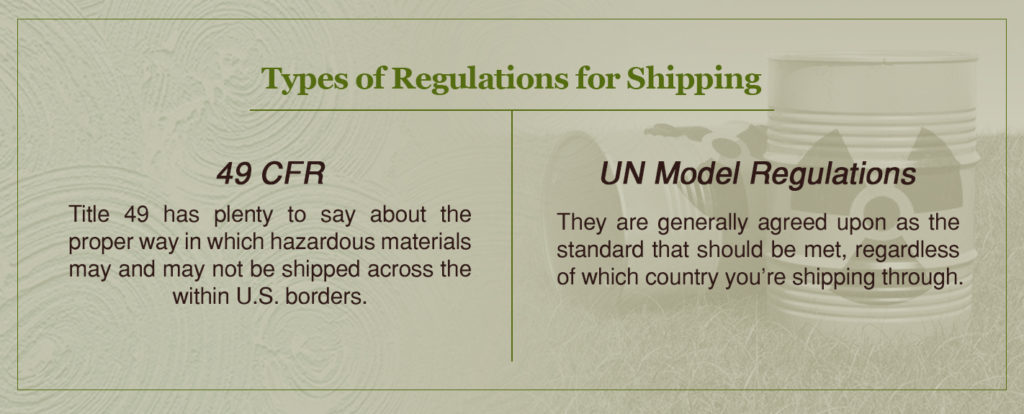
1. 49 CFR
Title 49 of the Code of Federal Regulations, also known as 49 CFR, is an extensive document that regulates all hazmat transportation across all different means of travel. It is relevant to materials being shipping into, out of and within the borders of the United States. The U.S. Department of Transportation is responsible for overseeing these regulations at the highest level.
Title 49 has plenty to say about the proper way in which hazardous materials may and may not be shipped across the within U.S. borders. While you can read 49 CFR in its entirety, the highlights are summarized below:
- All hazardous material must be fully described and assigned to the appropriate classification as designated by the material’s nature, such as explosive, corrosive or radioactive.
- Hazardous materials being shipped must not exceed the allotted limit per container or per shipped package.
- Only approved packages and packaging may be used to ship hazardous material.
- Packages and packaging must be tested to ensure they are up to the necessary standard to transport hazardous materials.
- All proper documentation must be present and included with the hazmat packaging as per detailed 49 CFR standards.
- All appropriate labels and marking must be present and visible on the package as stated in 49 CFR standards.
- Specific instructions and regulations regarding each classification of hazardous material must also be researched and met.
2. UN Model Regulations
While 49 CFR represents the standard for shipping hazardous materials within American borders, it doesn’t offer much guidance when it comes to shipping outside the country. For these standards, we need to look at the UN Model Regulations. The United Nations oversee these regulations, which represent the standard for international shipments of hazardous materials. While these rules may not be legally binding in a variety of countries, they are generally agreed upon as the standard that should be met, regardless of which country you’re shipping through.
It’s important to note that these UN-based guidelines may not line up directly with United States regulations. If you ship both domestically and internationally, you may need to comply with both sets of rules separately.
For specific information regarding the exact details of how to ship every possible type of hazardous material under every circumstance, you can read the complete UN Model Regulations for yourself. While there is far too much information contained within to summarize the entire thing, it’s a good idea to know the basics of what the Regulations cover. A few of the most critical topics you’ll find addressed there include:
- Differences in regulation depending on whether you’re shipping by ground or by air.
- Standards of labeling the outside of packages in a way that clearly denotes what is contained inside.
- UN packaging specifications regarding the type of packaging materials approved for use in transporting hazardous materials.
- Regulations regarding the exact classification and treatment of different categories of hazardous materials.
- Specific rules dealing with the type of documentation that must be present and accompany the shipment of hazardous materials.
- Rules governing the exact quantities of hazardous material that can be shipped, and the differences between shipping one quantity compared to another.
- Specific instructions regarding the treatment of one type of hazardous material compared to the treatment of another.
How to Ship
Do you have any hazardous material that you need to ship? If so, there’s a lot of preparation that goes into getting this material transported safely and responsibly to where you want it to go. It takes a bit of work and research, but with dedication, it’s entirely within your reach.
Broken down into easy to follow steps, here’s how to ship your hazardous material.
1. Determine Your Shipment’s Destination
Is your package traveling within U.S. borders, to the U.S. or out of the U.S.? In any of these cases, you’ll want to grab yourself a copy of 49 CFR and get familiar with it, as these will be the rules that govern your shipping process. If you’re shipping internationally, on the other hand, you’ll want to get your hands on a copy of the UN Model Regulations and get busy studying them.
2. Decide Which Category Your Hazardous Material Falls Into
As we’ve discussed, there are many types of hazardous material. Are you transporting radioactive material, toxic waste or solids that are dangerous when wet? All of these substances must be treated differently, and all of them are subject to different regulations under both 49 CFR and the UN Model Regulations. Determine which type of hazmat you’re transporting, and you’ll immediately find that you have a much smaller section of both of these documents to study.
3. Look up Any Specific Instructions Regarding Your Material
Explosives require different handling than corrosive substances. Radioactive material can’t be treated the same as toxic waste. Once you’ve determined which type of material you’re dealing with and which category it falls under, be sure to thoroughly read this section of the appropriate regulations and see if there are any specific instructions unique to this type of material. If not, your job is easy. If there are, however, realize that these rules are there for a reason, and you must comply with them.
4. Research How to Package Your Hazmat
A simple plastic bag or a cardboard box is not enough to contain a hazardous substance. Instead, you’ll need to invest in far more heavy-duty protection and packaging, no matter what it is that you’re transporting. Look at the relevant section of the appropriate shipping regulatory document and read the guidelines for how your type of material can and cannot be shipped. Once you have a good grasp on what packaging is appropriate, you’ll need to buy this and use it to package your material accordingly.
5. Package Your Hazmat Appropriately
Once you’ve acquired your approved packaging material, it isn’t as simple as just placing the material in the bags or boxes and shipping them off. Even if the packaging material is certified for use with hazardous material, it will still only be approved for up to a certain amount. You’ll need to carefully measure out the material into each package, ensuring that you don’t exceed the maximum limits in doing so. This may mean you use more containers than seem necessary, but this is ultimately the safest route and one that should not be challenged.
6. Add the Appropriate Labels
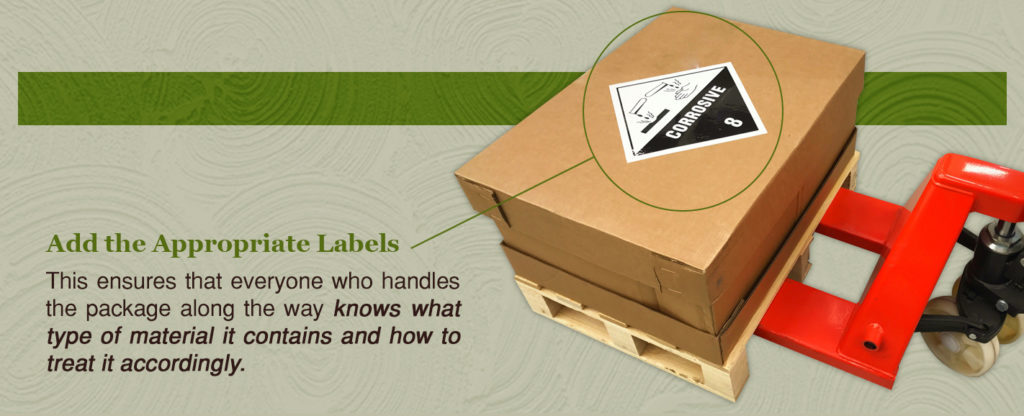
One of the most important aspects of shipping hazardous material is labeling it correctly. This ensures that everyone who handles the package along the way knows what type of material it contains and how to treat it accordingly. Labels like this help prevent accidents and keep everyone who comes into contact with a hazmat package a little safer.
Head to either 49 CFR or the UN Model Regulations and read up on what type of labels and markings need to be present on the outside of the package. Make sure these are in place and clearly visible so everyone who handles the package can read them easily.
7. Create the Proper Documentation
It isn’t enough to simply send your package through the mail, even if it is packaged and labeled properly. You must also send it with the correct documentation that explains what the package is and how it needs to be treated. Both 49 CFR and the UN Model Regulations will have further information regarding the specifications of this documentation, depending on what your package is. It’s essential that you remember to include this documentation, or you’ll risk being out of step with these regulations.
8. Ship Your Package
If you’ve carefully examined the relevant section of your ruling document and complied with every rule found there, then your job is finished. All that’s left is for you to send the package off, trusting that you did your job well. If you followed the regulations correctly, then you can feel confident the package will arrive at its destination without incident.
The Importance of Purchasing the Right Packages for Your Hazardous Materials
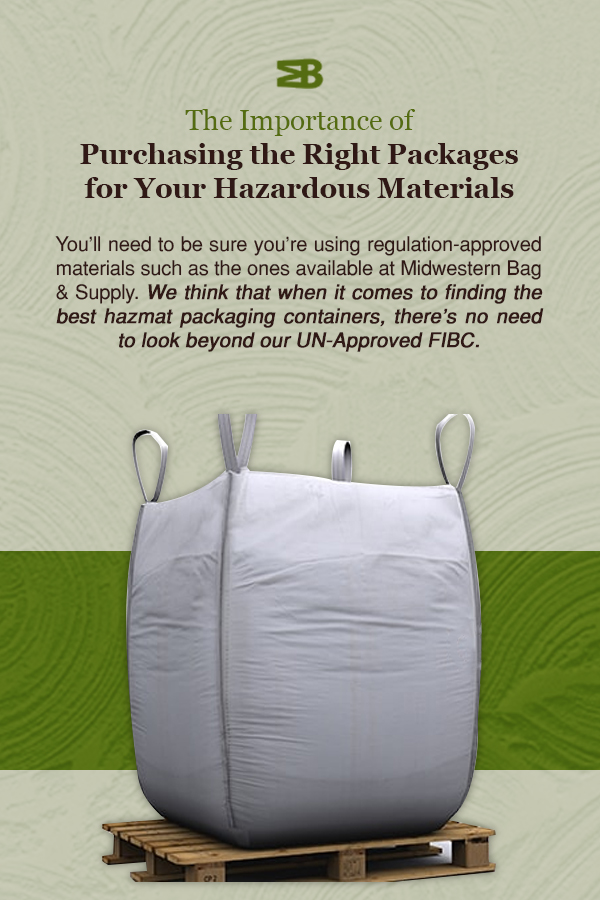
When it comes to packaging hazardous materials to send them off, you can’t be too careful. To get the job done right, you’ll need to be sure you’re using regulation-approved materials such as the ones available at Midwestern Bag & Supply. We think that when it comes to finding the best hazmat packaging containers, there’s no need to look beyond our UN-Approved FIBC.
The UN-Approved FIBC
FIBC stands for flexible intermediate bulk container, which is just another way of referring to flexible and durable bags perfect for shipping and packing. And while we offer plenty of FIBCs in a variety of shapes, sizes and designed uses, our UN-Approved FIBC might be just what you’re looking for.
These FIBCs have been specifically designed to transport hazardous material safely and built so they comply with the regulations laid out in the UN Model Regulations. We’ve tested and certified these bags so you can feel confident they’re the perfect solution for shipping dry, flowing goods in safety. Each bag carries the UN logo along with a code that provides more specific information about the bag and what it’s carrying. When you use these containers, you can always be sure your materials are in the best hands possible.
Get Your Hazmat Shipping Materials From Midwestern Bag & Supply
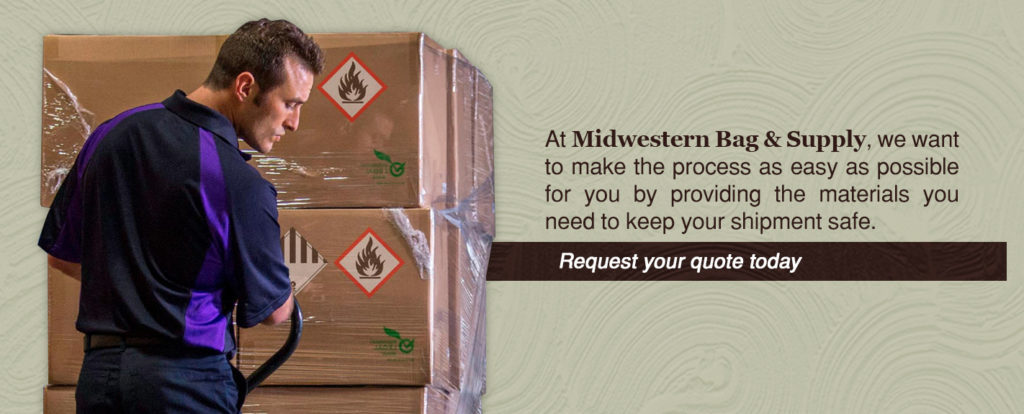
Ready to start planning and preparing your hazmat shipment? Here at Midwestern Bag & Supply, we want to make the process as easy as possible for you by providing the materials you need to keep your shipment safe. Learn why so many people trust us to provide their UN-approved shipping materials by contacting us to request your quote today.


 Copyright © 2024 Midwestern Bag. All Rights Reserved.
Copyright © 2024 Midwestern Bag. All Rights Reserved.